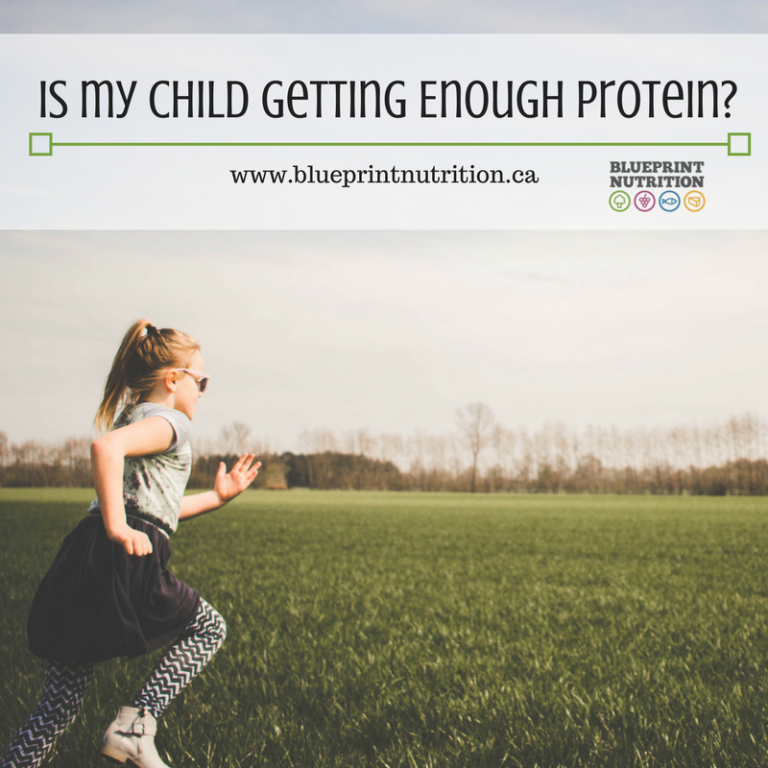In my years as a dietitian working in pediatrics, I have met many parents who are worried about their child’s nutrition. And when it comes time to the “learning eater” (aka “picky eater”), parents are typically concerned about the lack of vegetable or protein intake.
I thought I would start by addressing protein, because we all know that protein is a lot more “sexy” and “buzz-wordy” than vegetables! 🙂
I am by no means a protein guru. (Although I did learn a lot from the real protein guru, Dr. Stuart Phillips, during my time at McMaster University in the Kinesiology department, along with some other crazy smart grad students). But what I do know is that most parents have no cause for concern when it comes time to their children eating enough protein.
Lend me the next 5 minutes of your life and I will try to calm your fears!
What’s so important about protein for children?
In contrast to adults, children are actively growing and their energy needs are high to keep their little bodies running AND to fuel the growth of their body’s tissues. Research has shown that in children 0.5 to 13 years old, 58% of protein consumed is used for growth – most of that hamburger is making them grow!
Protein isn’t only involved in building muscle though – it is a key component of every cell in the human body – you need it to make enzymes and hormones and even your blood! In short, protein builds, maintains and replaces body tissues.
How much protein does my child need?
The amount of protein that children NEED is equal to the MINIMUM amount that they must eat to ensure age-appropriate growth. Scientists have worked hard to determine protein needs using the best methods available to them and have pulled all of this data into a very useful tool called the DRIs or Dietary Reference Intakes. The amount of protein that is estimated to cover the needs of 97.5% of the population is listed in this guide for males and females for various age groupings. Yes, 2.5% of the population will need more but in general, it’s safe to say that these numbers have you covered.
On average, we can say that children need approximately 1 gram of protein for every 1 kg of body weight. To figure this out, you simply multiple their weight (in kg) by the above factor.
- Children 1-3 years = 1.05 g/kg/d
- Children 4-13 years = 0.95 g/kg/d
- Children 14-18 years = 0.85 g/kg/d
i.e. A 2-year-old who weighs 11.8 kg (26 lbs)
11.8 x 1.05 = 12 grams protein [i.e. 1 cup whole milk (9g) + 1 Tbsp natural peanut butter (4g)]
i.e. An 9-year-old who weighs 25.9 kg (57 lbs)
25.9 x 0.95 = 25 grams protein [i.e. 1 egg (6g) + 2.5 oz chicken (17g) + 100g cup flavoured yogurt (3g)
i.e. A 14-year-old who weighs 105 pounds or 47.7 kg
47.7 x 0.85 = 41 grams protein [i.e. 1 cup milk (9g) + ¼ cup hummus (5g) + 4 oz turkey burger (26g)]
As you can see, it adds up pretty quickly and easily!
Is it best to get protein from meat?



Let’s try to think outside of the ‘meat box’ for a second if we can.
Meat is certainly a very concentrated source of high quality protein and provides other essential nutrients for children including iron, but a child who is following a vegetarian diet can certainly achieve optimal protein intakes from other sources, including beans, lentils, nuts, seeds, soy, dairy and eggs. (To enhance the absorption of iron from non-meat sources provide a food source of vitamin C along with it).
Beyond that, let’s not forget that whole grains contain protein, and there are small amounts in fruits and vegetables as well. Now, don’t get me wrong, the protein from fruits and veggies is slight in comparison to the meat and alternatives group and is certainly not a complete protein (i.e. don’t attempt to get all your protein needs from spinach) but everything adds up.
What about protein powder?
For your average little bear, this is not needed. You can easily get what you need from food, as demonstrated above.
Remember that protein powder doesn’t have the added vitamins and minerals that are found in whole food protein sources (i.e. iron, B12, and zinc in beef and calcium, vitamin D in milk). The average “scoop” of protein powder contains 20-30 grams of protein which would put your child’s protein intake through the roof!! And where does that extra protein go that the body doesn’t need? You flush it down the toilet. Yup, that’s right, your kidney’s do a fine job of getting rid of it and peeing it out.
Is it okay if my child only eats protein at supper?
We are only now beginning to learn more about this in an adult setting; unfortunately, there hasn’t been any research done on this topic directly in a younger paediatric population.
However, If what we have learned from adults rings true with children, spreading out protein intake more evenly during the day may have potential gains for building more muscle and perhaps contributing towards a healthier BMI. The alternative, which may not be as beneficial is to run out the door with only a banana in our bellies and save all of the protein for the 8 oz steak at supper.
A recently published study using data from the NHANES (National Health and Nutrition Examination Survey) 2013-2014 data pool illustrated that the participants (children 4-18 years-old) consumed the largest amounts of protein (and energy) at the midday and evening meal and much less at breakfast. Like I said, further implications of this are yet to be studied.
If you struggle to get protein into your child in the morning, try hard-boiled eggs, or add a spoonful of PB and hemp hearts to their oatmeal, or serve a glass of milk with their toast or top their whole wheat pancakes with some Greek yogurt.
For those “learning eaters” (aka picky eaters) just take what you get at each meal and don’t worry about timing; consider equal distribution as the icing on the cake.
When should I start to worry about my child’s protein intake?
If the variety of your child’s diet is very limited (i.e. will only eat French Fries and potato chips), and he or she is not eating any protein-containing foods and there may (or may not) be concerns around weight loss, please contact an RD.
Some cases where I have seen lower than desirable protein intakes include in children with Autism Spectrum Disorder (where there is very limited food diversity), severe food aversions, multiple food allergies, dietary restrictions imposed by parents (i.e. gluten-free, dairy-free, egg-free etc.), poorly balanced vegetarian or vegan diets.
Is it ok if my child eats more than the DRI for protein?
Yes. Most of us eat more than the minimum. If the extra protein is food based, and you don’t go overkill with the protein (i.e. Atkins – please don’t do that to your child!!!) then it’s fine. I’m happy if some added protein replaces white bread, candy or chips but don’t forget that other nutrients are just as important for growing kids including whole grains and healthy mono- and poly-unsaturated fats. (FYI – your child (and you!) should be getting more of your calories from healthy fats in a day’s time than from protein).
If you have a critically ill child (i.e. diagnosed with cancer or in the ICU at the hospital) protein needs are much higher (up to 2-3 times higher) – but don’t fret because the clinical dietitian will make sure that those needs are being met.
The Nuts and Bolts:
- Kids need protein to grow but baseline protein needs are likely lower than you think.
- Protein comes from more foods than just meat. Aim to include some plant-based protein sources into your child’s diet.
- Protein powder isn’t necessary, even for your athletic child. Instead, make a food-based smoothie if you like with banana, berries, spinach, avocado, flax, and Greek yogurt and milk served with their toast and PB.
- Aim to get equal amounts of protein at each meal if you can but don’t stress over it.
- Your child is likely getting enough unless their diet only consists of limited foods.
Do you have any other questions about protein for your child? Leave me a comment below or send me a note on my contact form and let’s connect.
Take it one bite at a time,
Rosanne
References:
- Coss-Bu, J.A et al. Protein Requirements of the Critically Ill Pediatric Patient. Nutrition in Clinical Practice 2017;32(1),128S-141S.
- Institute of Medicine. Dietary Reference Intakes for Energy, Carbohydrate, Fiber, Fat, Fatty Acids, Cholesterol, Protein, and Amino Acids (Macronutrients). Washington, DC: The National Academies Press; 2005.
- USDA Nutrient Database. Accessed May 10, 2017 at https://ndb.nal.usda.gov/ndb.
- Mathias, K.C., Almoosawi, S., Karagounis, L.G. Protein and Energy Intakes Are Skewed towards the Evening among Children and Adolescents in the United States: NHANES 2013-2014. The Journal of Nutrition.
- Mamerow MM et al. Dietary protein distribution positively influences 24-h muscle protein synthesis in healthy adults. J Nutr 2014;144:876-880.
- Leidy HJ et al. A high-protein breakfast prevents body fat gain, through reductions in daily intake and hunger, in “breakfast skipping” adolescents. Obesity 2015;23:1761-1764.






